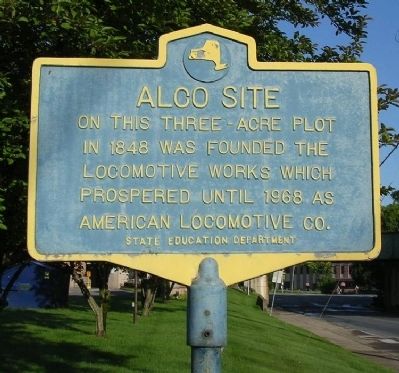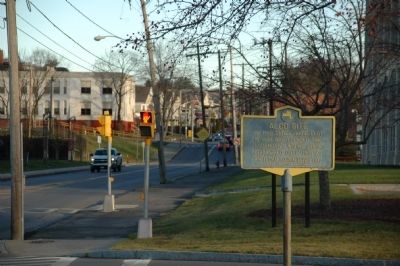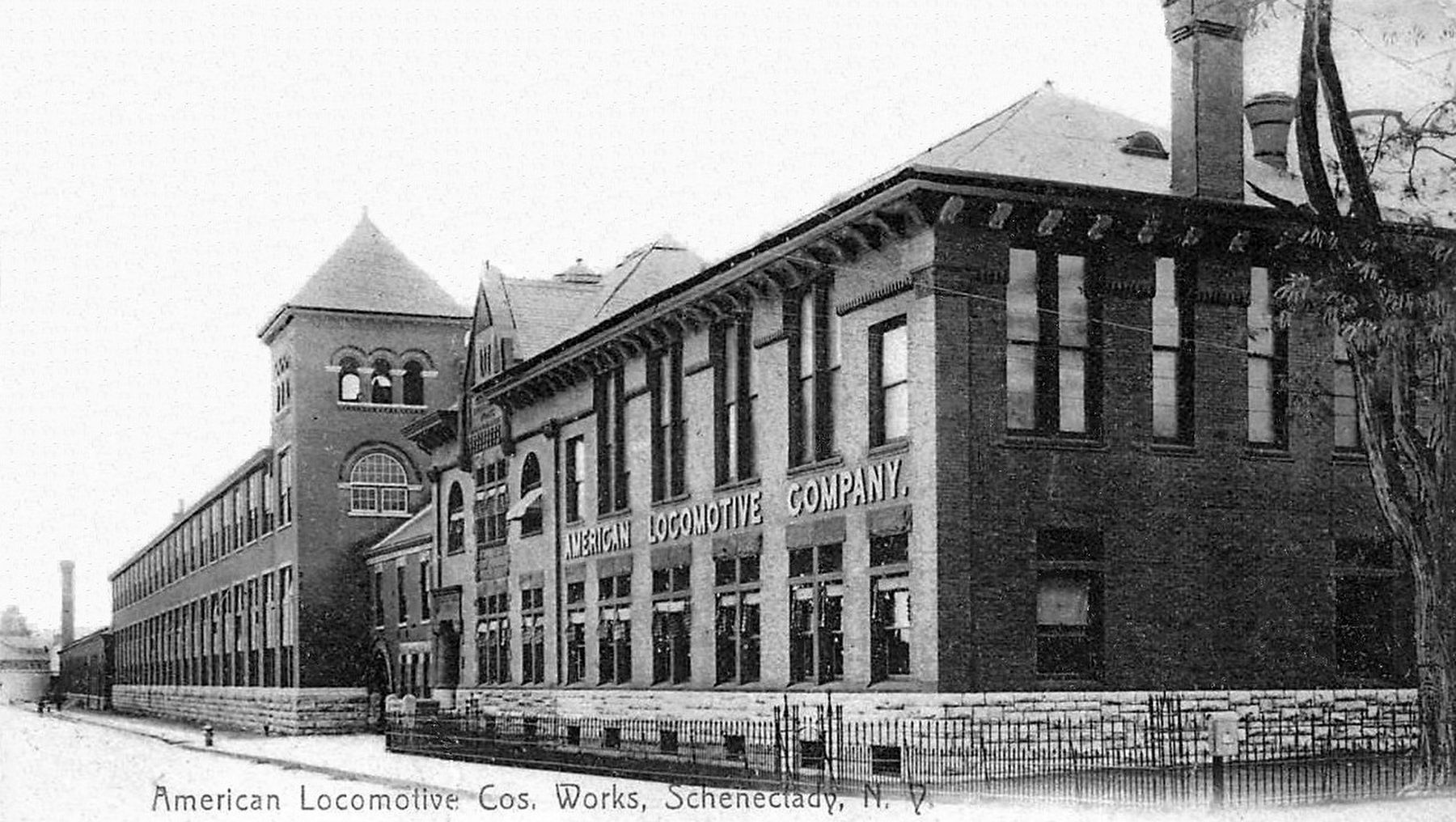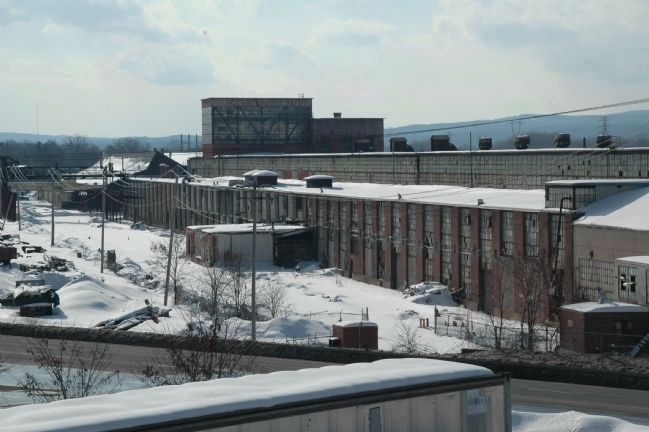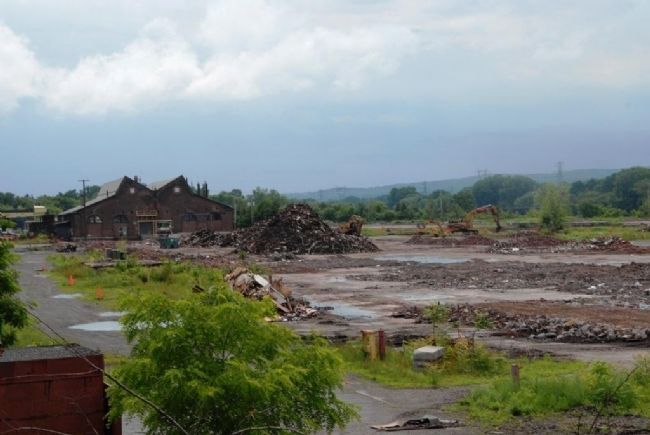Schenectady in Schenectady County, New York — The American Northeast (Mid-Atlantic)
ALCo Site
On this three-acre plot
in 1848 was founded the
locomotive works which
prospered until 1968 as
American Locomotive Co.
Erected by New York State Education Department.
Topics. This historical marker is listed in these topic lists: Industry & Commerce • Railroads & Streetcars • War, World II. A significant historical year for this entry is 1848.
Location. 42° 49.247′ N, 73° 55.996′ W. Marker is in Schenectady, New York, in Schenectady County. Marker is on Nott Street near Maxon Rd., on the right when traveling east. Touch for map. Marker is in this post office area: Schenectady NY 12308, United States of America. Touch for directions.
Other nearby markers. At least 8 other markers are within walking distance of this marker. Schenectady (approx. ¼ mile away); Streamliners (approx. ¼ mile away); The “Works” (approx. 0.3 miles away); Dewitt Clinton (approx. 0.3 miles away); ALCo's Legacy (approx. 0.3 miles away); Casey Jones (approx. 0.3 miles away); Nott Memorial (approx. 0.3 miles away); "Jupiter" (approx. 0.3 miles away). Touch for a list and map of all markers in Schenectady.
Regarding ALCo Site. Alco formed in 1901 with the merger of eight smaller locomotive manufacturers, including the Schenectady Locomotive Works, which had built locomotives at the Erie Boulevard site since the mid-1800s.
Between 1940 and 1945 ALCo was a major supplier of heavy machinery, during World War II. During that time ALCo produced: 4,488 steam and diesel electric locomotives, 7,362 army tanks, 3,314 M-7 tank destroyers, 2574 gun carriages, 2,300,000 shells, 410,010 fragmentation bombs. Employment went from 5,950 in 1941 to over 15,000 in 1945.
In 1941 ALCo built the largest locomotive in the world, the Union Pacific "Big Boy".
In June of 2010 a development group had purchased 57 acres of land that was at one time part of the ALCo Site for a remarkably low price of half a million dollars. The developer will demolishing Building 332 and more than a dozen others it owns on the site using state Brownfield Program credits. The project will feature condominiums and a marina along 1.5 miles of Mohawk River waterfront, retail shops, commercial offices and possibly a hotel.
Also see . . . The ALCo Historical & Technical Society. (Submitted on December 21, 2017, by Howard C. Ohlhous of Duanesburg, New York.)
Additional commentary.
1.
Schenectady, New York was once known as "The City that Lights and Hauls the World"--a dual reference to two prominent businesses located in the city; the Edison Electric Company (now known as General Electric), and the American Locomotive Company (ALCo).
— Submitted November 23, 2010, by Howard C. Ohlhous of Duanesburg, New York.
2. The Schenectady ALCo Site
"It's gone!" Historically speaking, this phrase has long been linked to some sort of significant loss. On Monday morning, April 15, 1912 at 2:20, I'm sure those words were uttered as the Titanic slipped beneath the icy waves of the North Atlantic when she foundered. Sunday evening, May 6, 1937, those words were probably heard at the naval air station in Lakehurst, NJ at 7:35 PM as the Hindenburg exploded and crashed to the ground in a hydrogen-fueled inferno. More recently, the events of September 11, 2001 have evoked that phrase as well when describing the World Trade Center. In the world of dieseldom, add that phrase to the month of July, 2001. The location: Schenectady, NY.
For many decades, the city of Schenectady, NY was billed as, "The city that lights and hauls the world". This was no misnomer as Schenectady was home to General Electric and the American Loomotive Company, more commonly known as Alco. Both plants were located a few short blocks from one another along Erie Boulevard and the banks of the Mohawk River. Locomotive production in Schenectady predates Alco,
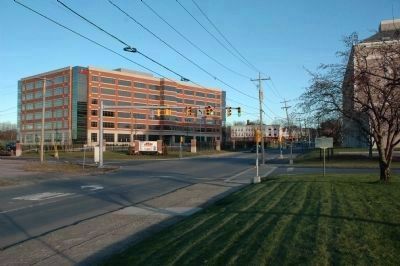
Photographed By Howard C. Ohlhous, November 24, 2010
3. ALCo Site Marker
The large building on the left of Nott Street is the new Golub Corporation headquarters which was dedicated on June 2, 2010. It sits on land that was at one time part of the sprawling ALCo site. The ALCo Site marker is posted in the grassy area on the right.
Alco's research and development department at Schenectady helped to transform engineering dreams into some of the most well-known locomotives of all-time. Who could forget the Milwaukee's Hiawathas, New York Central Niagras, Union Pacaific's Big Boys, NIckel PLate's Berkshires, as well as the Mohawk, the Hudson, and the Mallet type steam engine? In 1940, this plant pioneered the first true road switcher locomotive, the RS1, at the urging of the Rock Island. IN 1948 when Alco produced its last steam locomotive, they had produced over 75,000 locomotives. This plant went on to produce the famous PA diesels, considered by many to be the most beautiful locomotive ever constructed. It's final line of diesels, the Century Series, closed out over 100 years worth of engineering dreams.
A lesser-known fact was that this plant played a significant role in the success of the United States during World War II. The Schenectady facility turned out over 6,000 tanks for the war effort. They produced 1,000 M-7 tanks which were used to defeat Erwin Rommel and the Nazi regime in North Africa. All of these were produced in Schenectady, NY. They also produced gun forgings, marine boilers, turrets, and other necessary tools of war for the US.
In the 1950s, with steam engine production long since finished and World War II long-gone, Alco embarked on a major plant modernization to facilitate diesel production. More than one-third of the 112-acre plant was demolished. New assembly-line production bays were installed to make the production of locomotives more efficient. All of these efforts came as too-little, too-late for Alco. By the 1950s, Alco was the number2 locomotive builder, and a distant number 2 at that to EMD. In 1960, Alco's one-time partner in diesel production, General Electric, annnounced their production of road locomotives. This doomed Alco to the number 3 position in locomotive building. Even with the refinement of their 251 prime mover and the introduction of their Century Series locomotives, Alco could not stave off the inevitable. In January, 1969, Alco rolled out its last new locomotive, a T6 switcher for the Newburg and South Shore Railroad of Cleveland, Ohio. One hundred twelve years of locomotive
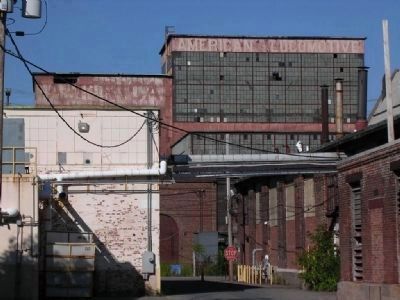
Photographed By Howard C. Ohlhous, August 9, 2006
5. ALCo Site - Building 332
The buildings in this photo are part of the former ALCo site. The taller building on the right is part of Building 332 and contained the boiler works. Building 332 was one of the longest structures in the world at nearly 1,000 feet when it was completed in 1905. The top of the building reads AMERICAN LOCOMOTIVE in the band of bricks at the top, a long time Schenectady landmark. The building was scheduled for demolision near the end of 2010.
Following the closure of the plant, General Electric acquired and adapted severeal of the huge buildings for their usage. This lasted until the early 1980s when GE no longer needed the overflow space. The Schenectady Industrial Development Agency had acquired the property and converted it to an industrial park. This lasted for approximately two decades until the park was phased out. Various uses of the old Alco plant were floated, including converting the site to luxury condominiums. However, over a century of pollution from manufacturing deemed the site nearly unusable. In the fall of 2010, it was announced that demolition would begin on the remaining buildings.
It was this news that prompted me to make one last pilgrimage to the birthplace of locomotives that I've spent thousands of happy miles tracking down throughout the US and Canada. I first saw the Alco plant in September, 1998. Building 62, the main erecting shop, still had "American Locomotive" proudly emblazoned on the top of it, albeit very faded. The site still looked impressive. There hadn't been much news about the progress of the plant's demise, so I assumed as my friend Bruce Hodges and I drove down Erie Boulevard on July 3 to still see Building 62 and "American Locomotive" one last time. What greeted us was gut-wrenching for any Alco enthusiast. There
was no more Building 62, no more paint shop, and no more truck and sheet metal shop. All that was left were piles of rubble, the old Alco general office building at the corner of Erie Boulevard and Nott Street, the guard shack, Building 45, and a portion of a warehouse in the process of being torn down. The weather that day was gloomy, and it fit my spirits as I solemnly walked along the perimeter of the facility on Erie Boulevard. A musty smell filled the air, eminating from the buildings and rubble that lay on the other side of the fence. Documenting what little was left was a bitter-sweet experience. I thought about the achievements that were envisioned and willed into solid reality at this plant, the tens of thousands of proud workers who toiled here to produce these machines, and that sad day in January 1969 when all of this came to an end. Most likely by the end of the July, all that will be left is a vacant field of dreams. It was a very sad, hard reality for this die-hard fan of Alco locomotion.
The hallowed halls of Alco now join those of the Baldwin Locomotive Works, EMD's La Grange plant, the Edmund Fitgerald, the Titanic, and many others in the growing list of things to forever pass away from the contemporary scene. It's gone!
Jim Rowland, President Lehigh Valley Chapter,
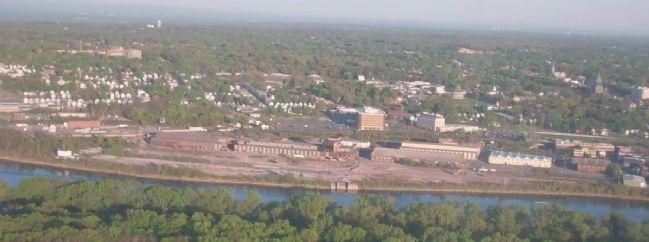
Photographed By Nick Skinner
7. ALCo Site - Aerial View
The former ALCo buildings are the long buildings in the center of the photo, just south of the Mohawk River. The $300 million Rivers Casino & Resort in Schenectady, scheduled for its Grand Opening on February 8th 2017, is built on the site of the former ALCo plant.
— Submitted July 27, 2011, by Howard C. Ohlhous of Duanesburg, New York.
Additional keywords. ALCO, ALCo Union College Rivers Casino
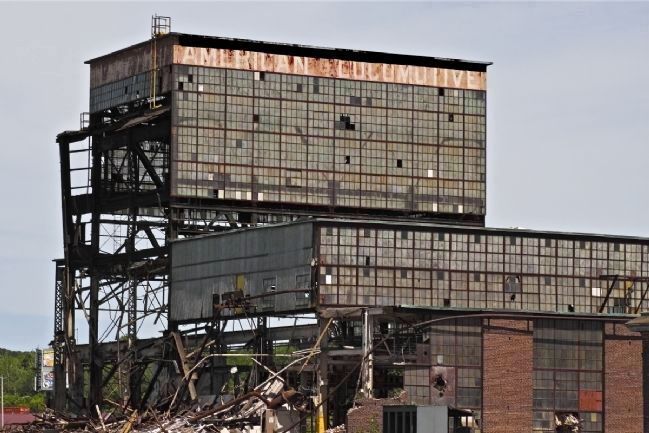
Photographed By "95Wombat", June 19, 2011
8. "Alco's Last Gasp"
The last bit of Building 62 in the old ALCo locomotive complex in Schenectady, N.Y.
For 17 years I’ve been driving past this on the way to work, and each year the words “American Locomotive” have been a bit more faded. Finally this morning, the sign came down.
Building 62 stretched almost a thousand feet, and was one of the longest factory structures in the world when completed in the early 1900s. Old photos make it look like a beehive inside, with workers swarming around a floor crowded with locomotives that rail buffs now call classics.
Alco went out of business over 40 years ago, and its old factory was a mess even before demolition started. Once everything is cleaned up, and once somebody comes up with $200 million, a new residential/business community is to be built here.
June 19, 2011 - "95wombat"
For 17 years I’ve been driving past this on the way to work, and each year the words “American Locomotive” have been a bit more faded. Finally this morning, the sign came down.
Building 62 stretched almost a thousand feet, and was one of the longest factory structures in the world when completed in the early 1900s. Old photos make it look like a beehive inside, with workers swarming around a floor crowded with locomotives that rail buffs now call classics.
Alco went out of business over 40 years ago, and its old factory was a mess even before demolition started. Once everything is cleaned up, and once somebody comes up with $200 million, a new residential/business community is to be built here.
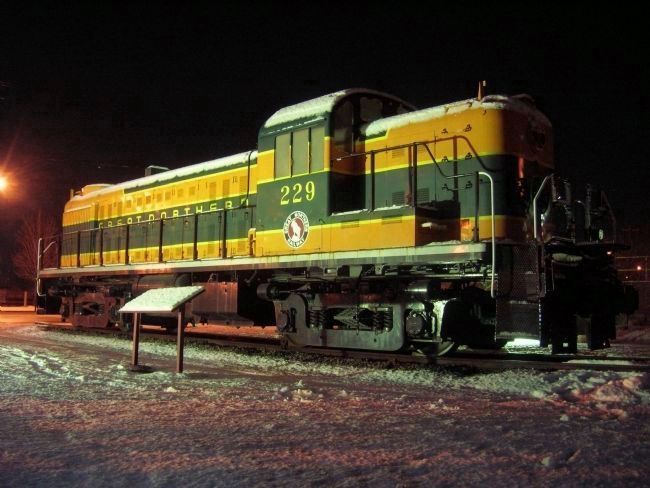
Photographed By Howard C. Ohlhous, February 3, 2007
10. 1953 ALCo on Display
This is an RS-3 diesel-electric locomotive built by ALCo in Schenectady as 1 of 1,370 RS-3s from May 1950 through August 1956. This locomotive was designed and used as a road switcher. and now is on display along Nott Terrace in Schenectady near the Schenectady Museum which is about a mile away from the former ALCo site.
Credits. This page was last revised on December 29, 2017. It was originally submitted on November 23, 2010, by Howard C. Ohlhous of Duanesburg, New York. This page has been viewed 3,162 times since then and 213 times this year. Photos: 1. submitted on November 23, 2010, by Howard C. Ohlhous of Duanesburg, New York. 2, 3. submitted on November 25, 2010, by Howard C. Ohlhous of Duanesburg, New York. 4. submitted on December 21, 2017, by Howard C. Ohlhous of Duanesburg, New York. 5. submitted on November 24, 2010, by Howard C. Ohlhous of Duanesburg, New York. 6. submitted on April 1, 2011, by Howard C. Ohlhous of Duanesburg, New York. 7. submitted on August 1, 2011, by Howard C. Ohlhous of Duanesburg, New York. 8, 9. submitted on July 27, 2011, by Howard C. Ohlhous of Duanesburg, New York. 10. submitted on November 24, 2010, by Howard C. Ohlhous of Duanesburg, New York. • Bill Pfingsten was the editor who published this page.
